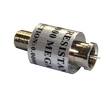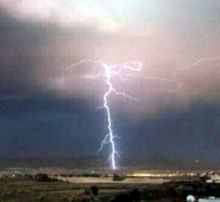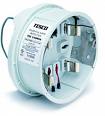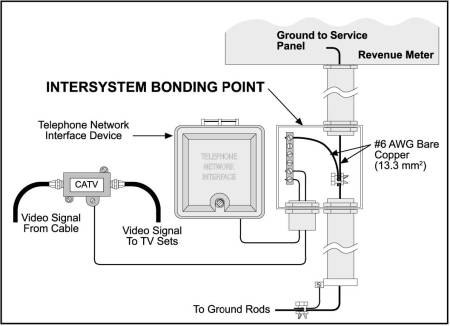 Energy Phantoms or Vampires account for approximately 5% of the electrical energy used in every household, spread that across every home in the US and it adds ups up to 65 billion kilowatt-hours of wasted electricity each year.
Energy Phantoms or Vampires account for approximately 5% of the electrical energy used in every household, spread that across every home in the US and it adds ups up to 65 billion kilowatt-hours of wasted electricity each year.
As quoted from the Investigations of Leaky Electricity in the USA paper ….. the average US house leaks constantly about 50 Watts. This is approximately five percent of the residential electricity use in the US. Leaking electricity falls into three major categories: video, audio and communication. Video equipment such as TVs, VCRs, cable boxes and satellite earth stations account for the largest share of residential leaking electricity, approximately 35%. Audio equipment accounts for 25% of standby consumption, and communication devices (answering machines, cordless phones and fax machines) are responsible for an additional 10%.
Energy vampires can be defined as electrical devices that consume an amount of energy by doing nothing but waiting to be activated or used. This standby mode can be most recognizable in TV’s, video and audio equipment. But it really goes way beyond that.
Some of the common energy wasters in most homes are the adapters (aka: wall warts) that come with rechargeable battery-powered cordless phones, cell phones, digital cameras. You will also find them with many music players, power tools, and other electronic devices.
Conceptually, if you can just unplug all of them when not in use, this would solve much of the problem. Easier said than done. Being the techno geek that I am, there will always be a another way.
- Individual Timers: You can use traditional electrical timers or this new style like this Belkin unit. It is designed specifically for applications that only need to be on for a certain amount of time where the specific time of the day is not important. At $10 bucks, it might be a good solution for your clothes iron, electric tooth-brush or MP3 player.
- Group Timers: Combined with a surge protector, these devices will not only protect the equipment connected, but also shut them down to cut off the phantom load. Price wise, they are still in the same range as a regular surge protector/power strip. Additionally, many of them include a couple of priority plugs that stay energized all the time.
- X10 Technology: If you read my article on X10 Technology, you may have already figured this out. Combined with your X10 units and the software package, you can set timed events for all of these devices. Or combine one with a power strip. If its possible; try to cluster all of these type devices into groups. Plug all of them into a power strip, then plug the power strip into the X10 timer. Schedule the timer to run only a certain amount of hours per day. Probably 3-5 hours max. For devices like televisions, DVR’s and audio equipment; try to do the same thing. If you dont use X10 timers, any traditional timer will work as well. (TIP: If you have a cable box, U-Verse or satellite receiver, it would be best, not to cycle this device on and off. It is very normal for the service providers to perform late night downloads to update your software, turning them off at night may be problematic and cause you to have some service interruptions or cause you to miss some updates.)
- Energy Star Equipment: As part of the design specification, most energy star devices do a good job in reducing the phantom loads. However, because devices like televisions, microwaves and DVR’s usually have clocks in them, they will still use a little bit of energy. If you choose to shut these devices down, just understand that the device might require you to re-set the clock every time. The only way to find out, is to try it.
Managing Other Electric Devices: Here are a few tips for keeping the energy usage in check on the non-techy type equipment:
- Refrigerators: This device can use as much as 20% of your total consumed AC energy. Most new refrigerators with electronic thermostats come preprogrammed to run 0F and 40F (freezer/refrigerator). If you have an older style, use a thermometer to make the adjustment. Set the freezer between 0-3F. TIP: Energy Star rated refrigerators will make a significant impact on your energy usage.
- Clothes Dryers: Use the cold or warm cycle s as much as you can. Avoid the hot cycle.
- Dishwasher: Always run it full. Dry them cool instead of hot. Drying cool does not impact the dishwashers ability to sanitize the dishes. However, you may have to wipe them off before you store them. Doing this will reduce the dishwasher energy used by 20%.
- Water Heater Thermostats: The default setting for water heaters is 140F, 120 will work in most cases. If you live in the southern part of the US, it is easy to drop the temperature during the summer. You will never notice the difference.
- Set Back Thermostat: Even though this does not technically fit into this article, it is a pivotal element in energy reduction. Worth an article on its own!!
- Energy Star Rating: Look here first when replacing appliances. These subtle changes will make positive affect on your overall energy usage
 The Gas Gauge (Geek Overload): Believe it or not; studies show that if we are able to monitor the amount of usage of a product (while in use) it will cause us to use less. There are multiple devices on the market today; such as TED, Power Cost Monitor, and Energy Monitor that will provide instant feed back on energy usage. You will be able to see all the energy vampires at any time of the day. Some of them have software with data loging history, peak demand and the list goes on. Its pretty cool (geeky) to walk around the house and start yanking plugs and watching the meter drop. (NOTE: The devices mentioned may require installation, in some cases they only work with certain brand of meters. Read the webpages carefully before purchasing).
The Gas Gauge (Geek Overload): Believe it or not; studies show that if we are able to monitor the amount of usage of a product (while in use) it will cause us to use less. There are multiple devices on the market today; such as TED, Power Cost Monitor, and Energy Monitor that will provide instant feed back on energy usage. You will be able to see all the energy vampires at any time of the day. Some of them have software with data loging history, peak demand and the list goes on. Its pretty cool (geeky) to walk around the house and start yanking plugs and watching the meter drop. (NOTE: The devices mentioned may require installation, in some cases they only work with certain brand of meters. Read the webpages carefully before purchasing).
Google Power Meter: In their “save the world mentality” Goggle has teamed with some utilitiy and equipment providers to allow you to view your usage on line. Neat idea and its free, but has limited availability.
TOP Household Electricity Vampires (Courtesy of Lawrence Berkley Laboratory)
| Appliance | Saturation | Watts | Watts / House |
| TV | 180% | 6 | 10.8 |
| Cable boxes | 50% | 20 | 10.0 |
| VCR | 80% | 10 | 8.0 |
| Compact audio | 67% | 10 | 6.7 |
| Answering machines | 60% | 5 | 3.0 |
| Alarms | 19% | 15 | 2.9 |
| Video games | 55% | 5 | 2.8 |
| Portable stereos | 65% | 3 | 2.0 |
| Rechargeable vacuum | 20% | 5 | 1.0 |
| Cordless phones | 49% | 2 | 1.0 |
| Fax | 4% | 15 | 0.6 |
| Satellite | 5% | 11 | 0.6 |
| Toothbrush | 13% | 3 | 0.4 |
| Smoke detectors | 84% | 0.4 | 0.3 |
| TOTAL | 50.0 |
So what is this in dollars and cents. For example; if you use 1000kW per month at .12 per kW, that works out to be about $6 bucks a month. (1000X.12)*.05=6. Unless you are prepared to take some drastic measures, you may be lucky to cut 50 to 60% of that number. So look for $3-5 per 1000kW used as a target.
Okay, this article might be a little anal, to gain back $6 bucks a month as a payback period is not worth recognizing. However; look at it like a leaky faucet. Its not a bad idea, and long term its will save you a couple of bucks and if everyone did it we would have less dependency on the grid.




 Posted by homeownerbob
Posted by homeownerbob 














